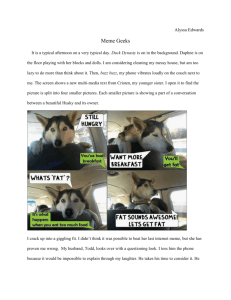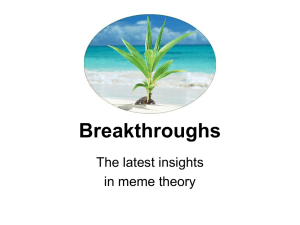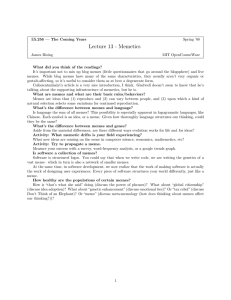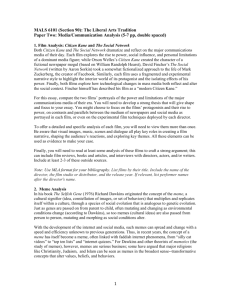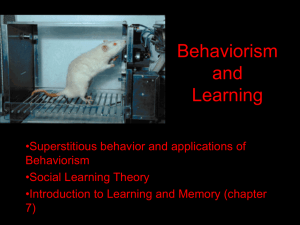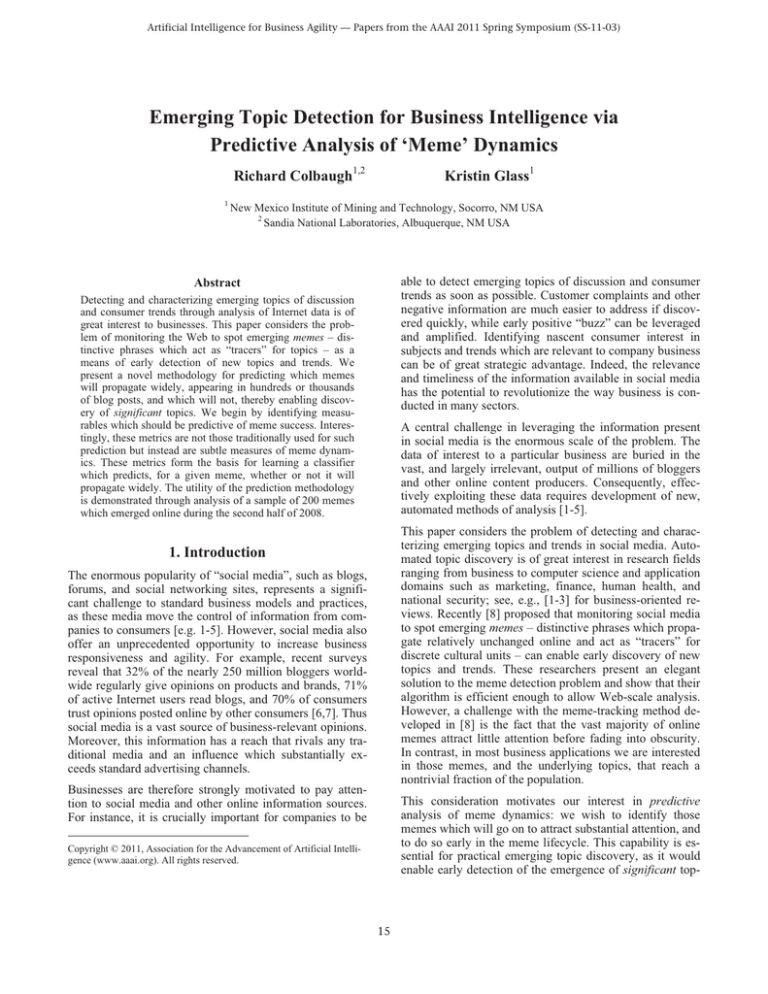
Artificial Intelligence for Business Agility — Papers from the AAAI 2011 Spring Symposium (SS-11-03)
Emerging Topic Detection for Business Intelligence via
Predictive Analysis of ‘Meme’ Dynamics
Richard Colbaugh1,2
1
Kristin Glass1
New Mexico Institute of Mining and Technology, Socorro, NM USA
2
Sandia National Laboratories, Albuquerque, NM USA
able to detect emerging topics of discussion and consumer
trends as soon as possible. Customer complaints and other
negative information are much easier to address if discovered quickly, while early positive “buzz” can be leveraged
and amplified. Identifying nascent consumer interest in
subjects and trends which are relevant to company business
can be of great strategic advantage. Indeed, the relevance
and timeliness of the information available in social media
has the potential to revolutionize the way business is conducted in many sectors.
Abstract
Detecting and characterizing emerging topics of discussion
and consumer trends through analysis of Internet data is of
great interest to businesses. This paper considers the problem of monitoring the Web to spot emerging memes – distinctive phrases which act as “tracers” for topics – as a
means of early detection of new topics and trends. We
present a novel methodology for predicting which memes
will propagate widely, appearing in hundreds or thousands
of blog posts, and which will not, thereby enabling discovery of significant topics. We begin by identifying measurables which should be predictive of meme success. Interestingly, these metrics are not those traditionally used for such
prediction but instead are subtle measures of meme dynamics. These metrics form the basis for learning a classifier
which predicts, for a given meme, whether or not it will
propagate widely. The utility of the prediction methodology
is demonstrated through analysis of a sample of 200 memes
which emerged online during the second half of 2008.
A central challenge in leveraging the information present
in social media is the enormous scale of the problem. The
data of interest to a particular business are buried in the
vast, and largely irrelevant, output of millions of bloggers
and other online content producers. Consequently, effectively exploiting these data requires development of new,
automated methods of analysis [1-5].
This paper considers the problem of detecting and characterizing emerging topics and trends in social media. Automated topic discovery is of great interest in research fields
ranging from business to computer science and application
domains such as marketing, finance, human health, and
national security; see, e.g., [1-3] for business-oriented reviews. Recently [8] proposed that monitoring social media
to spot emerging memes – distinctive phrases which propagate relatively unchanged online and act as “tracers” for
discrete cultural units – can enable early discovery of new
topics and trends. These researchers present an elegant
solution to the meme detection problem and show that their
algorithm is efficient enough to allow Web-scale analysis.
However, a challenge with the meme-tracking method developed in [8] is the fact that the vast majority of online
memes attract little attention before fading into obscurity.
In contrast, in most business applications we are interested
in those memes, and the underlying topics, that reach a
nontrivial fraction of the population.
1. Introduction
The enormous popularity of “social media”, such as blogs,
forums, and social networking sites, represents a significant challenge to standard business models and practices,
as these media move the control of information from companies to consumers [e.g. 1-5]. However, social media also
offer an unprecedented opportunity to increase business
responsiveness and agility. For example, recent surveys
reveal that 32% of the nearly 250 million bloggers worldwide regularly give opinions on products and brands, 71%
of active Internet users read blogs, and 70% of consumers
trust opinions posted online by other consumers [6,7]. Thus
social media is a vast source of business-relevant opinions.
Moreover, this information has a reach that rivals any traditional media and an influence which substantially exceeds standard advertising channels.
Businesses are therefore strongly motivated to pay attention to social media and other online information sources.
For instance, it is crucially important for companies to be
This consideration motivates our interest in predictive
analysis of meme dynamics: we wish to identify those
memes which will go on to attract substantial attention, and
to do so early in the meme lifecycle. This capability is essential for practical emerging topic discovery, as it would
enable early detection of the emergence of significant top-
Copyright © 2011, Association for the Advancement of Artificial Intelligence (www.aaai.org). All rights reserved.
15
ics and trends. Standard approaches to predictive analysis
of social diffusion phenomena like meme propagation assume, either explicitly or implicitly, that diffusion events
which “go viral” are inherently different from those that
don’t, and focus attention on trying to identify these crucial
differences (see [9,10] for background on social diffusion).
Recent research calls into question this intuitively plausible
premise and, indeed, indicates that intuition can be an unreliable guide to identifying successful prediction methods.
For example, the studies reported in [11-14] indicate that
the “intrinsic” attributes commonly believed to be important when assessing the likelihood of adoption of cultural
products, such as the quality of the product itself, do not
possess much predictive power. This research offers evidence that, when individuals are influenced by the actions
of others, it may not be possible to obtain reliable predictions using methods which focus on intrinsics alone; instead, it may be necessary to incorporate aspects of social
influence into the prediction process.
2. Problem Formulation
This section begins by defining the class of memes of interest and providing a more precise statement of the meme
prediction problem. We then introduce the datasets we use
to investigate meme prediction and briefly characterize
relevant attributes of the dynamics of meme propagation.
The goal of this paper is to develop a methodology for understanding and predicting the way memes – distinctive
phrases which act as “tracers” for topics – diffuse through
online news and social media. We focus on phrases which
1.) appear in online sources as quoted material, and 2.)
propagate largely unchanged through sequences of news
articles and blog posts. Our main source of data on meme
dynamics is the publicly available datasets archived at
http://memetracker.org [15] by the authors of [8]. Briefly,
the study [8] develops an efficient and elegant algorithm
for meme detection and applies the algorithm to data obtained from Spinn3r (http://spinn3r.com). The raw Spinn3r
data used in [8] consist of all news articles and blog posts
published on the approximately 20 000 news sites and 1.6
million blogs indexed by Spinn3r during the period 1 August to 31 December 2008. Application of the meme detection method proposed in [8] to the Spinn3r data resulted in
the extraction of over 112 million phrases, and a significant
portion of these data have been made available at [15].
Recognizing this challenge, this paper proposes that generating useful predictions about social dynamics requires
careful consideration of the way individuals influence one
another through their social networks. We present a powerful new methodology for predictive analysis of social diffusion which exploits information about network topology
and dynamics to accurately forecast which memes will
propagate widely, appearing in hundreds or thousands of
blog posts, and which will not. The particular network features used by the prediction algorithm are those identified
as likely to be predictive of meme success by our recently
proposed predictability assessment method [11]. Interestingly, the metrics nominated by this theoretical analysis as
the ones expected to possess significant predictive power
turn out to be fairly subtle measures of the network dynamics associated with early meme diffusion. Meme prediction
is accomplished by learning an algorithm which, based
upon very early network dynamics, is able to successfully
identify which memes will ultimately propagate widely
and which will not.
We are interested in developing capabilities to perform two
main operations: 1.) efficient meme monitoring, which
involves the identification of a few good “sensor blogs”
through which to observe the emergence and evolution of
memes, and 2.) meme prediction, the goal of which is to
distinguish successful and unsuccessful memes early in
their lifecycle. More precisely, we have the following two
predictive analysis problems:
x Monitoring: 1.) investigate whether there exist good sensor blogs for memes, that is, a small number of blogs
that consistently detect successful memes early; if so, 2.)
characterize these sensor blogs and employ them to increase the efficiency and effectiveness of the meme detection method of [8].
The paper makes three main contributions. First, we propose a set of novel network dynamics-based metrics which
possess significant predictive power for social diffusion
processes like meme propagation; indeed, these metrics are
found to be considerably more predictive than standard
measures. Second, we develop a machine learning-based
classification algorithm which employs these network dynamics metrics to accurately predict, very early in the lifecycle of a meme of interest, whether that meme will diffuse widely or not. Third, the utility of the prediction algorithm, and the power of network-based predictive metrics,
are demonstrated through an empirical study involving
“successful” and “unsuccessful” memes associated with
topics of discussion that emerged in social media during
the second half of 2008. Perhaps surprisingly, we find that
although memes typically propagate for weeks, useful predictions can be made within the first twelve hours after a
meme is detected.
x Prediction: 1.) identify measurables which are predictive
of meme success (e.g., post sentiment, early meme dynamics), and 2.) use these predictive measurables as the
basis for classifying memes into two groups – those
which will ultimately be successful (here, acquire t1000
posts) and those that will be unsuccessful (attract d100
posts) – very early in the meme lifecycle.
To support an empirical evaluation of our proposed solutions to the above problems, we downloaded from [15] the
time series data for slightly more than 70 000 memes.
These data contain, for each meme M, a sequence of pairs
(t1, URL1)M, (t2, URL2)M, …, (tT, URLT)M, where tk is the
time of appearance of the kth blog post or news article that
contains at least one mention of meme M, URLk is the
URL of the blog or news site on which that post/article was
published, and T is the total number of posts that mention
16
meme M. From this set of time series we randomly selected 100 “successful” meme trajectories, defined as those
corresponding to memes which attracted at least 1000 posts
during their lifetimes, and 100 “unsuccessful” meme trajectories, defined as those whose memes acquired no more
than 100 total posts. It is worth noting that, in assembling
the data in [15], all memes which received fewer than 15
total posts were deleted, and that ~50% of the remaining
memes have 50 posts; thus the large majority of memes
are unsuccessful by our definition (as well as according to
the criteria of most business intelligence applications [15]). Figure 1 depicts the distribution of meme success for
the full set of ~70 000 memes obtained from [15].
interest. This property may be a reflection of the role of
social influence in meme dynamics: individuals and organizations become aware of memes and judge their appeal in
part by observing others, and as a consequence successful
memes may attract attention not because they are particularly interesting but instead simply because they’ve attracted attention in the past [e.g., 12,14]. It is known that
predicting the evolution of such “rich get richer” phenomena using standard methods is quite difficult [11-14].
Memes also exhibit highly variable times to acquire their
first few posts and to accumulate their final tally of posts.
Figure 2 reports the mean and median times required for
successful and unsuccessful memes to attract five, ten, and
their total number of posts. It is interesting to note that the
median times for unsuccessful memes to attract early posts
is actually shorter than the corresponding times for successful memes. This figure also provides an illustration,
taken from [8], of the evolution of several successful
memes. It can be seen that some of these memes receive
their posts quickly while others become prominent only
after substantial time has elapsed.
Figure 1. Cumulative distribution of meme success. The
log-log plot shows the number of memes (vertical axis)
which acquired at least a given number of posts (horizontal axis) during their lifetimes.
Two other forms of data were collected for this study: 1.) a
large Web graph which includes websites (URLs) that appear in the meme time series, and 2.) samples of the text
surrounding the memes in the posts which contain them.
More specifically, we sampled the URLs appearing in the
time series for our set of 200 successful and unsuccessful
memes and performed a Web crawl that employed these
URLs as “seeds”. This procedure generated a Web graph,
denoted Gweb, that consists of approximately 550 000 vertices/websites and 1.4 million edges/hyperlinks, and includes essentially all of the websites which appear in the
meme time series. To obtain samples of text surrounding
memes in posts, we randomly selected ten posts for each
meme and then extracted from each post the paragraph
which contains the first mention of the meme.
Early Meme Dynamics
Successful Memes (!1000 posts)
#posts
5
10
total
mean (hr)
108
171
~4400
median (hr)
18.5
41.5
~4400
Unsuccessful Memes (100 posts)
#posts
5
10
total
mean (hr)
375
765
~1010
median (hr)
10.1
30.5
~410
Figure 2. Meme dynamics. In the “stacked” plot at top, thread
thickness corresponds to number of posts/articles mentioning
the particular meme during that time period (horizontal axis)
[8]. The table at bottom reports the mean and median time (in
hours) required for successful and unsuccessful memes to
acquire five posts, ten posts, and their total number of posts.
Meme dynamics possess several characteristics which are
likely to make predictive analysis challenging. For example, as shown in Figure 1, the distribution for meme success is strongly right-skewed, with most memes receiving
relatively little attention and a few attracting considerable
17
rables under consideration allows identification of the candidate starting set (CSS), that is, the set of states and system parameter values which represent initializations that
are consistent with, and equivalent under, the presumed
observational capability. As a simple example, consider an
online market with two products, A and B, and suppose the
system state variables consist of the current market share
for A, ms(A), and the rate of change of this market share,
r(A) (ms(B) and r(B) are not independent state variables
because ms(A) ms(B) 1 and r(A) r(B) 0); let the
parameters be the advertising budgets for the products,
bud(A) and bud(B). The producer of item A might find it
useful to define the SSI to reflect market share dominance
by A, that is, the subset of the two-dimensional state space
where ms(A) exceeds a specified threshold (and r(A) can
take any value). If only market share and advertising budgets can be measured then the CSS is the one-dimensional
subset of state-parameter space consisting of the initial
magnitudes for ms(A), bud(A), and bud(B), with r(A) unspecified (the one-dimensional “uncertainty” in the CSS
reflects the fact that r(A) is not measurable).
3. Predictive Analysis
In this section we begin by summarizing the application of
the predictability assessment process [11,12] to a simple
model of meme diffusion. This procedure identifies two
features of the network dynamics which should be useful
for distinguishing successful and unsuccessful memes early
in their lifecycle. We then consider the meme monitoring
problem, in which the objective is to identify and characterize blogs and other online sources that consistently
detect successful memes early in their lifecycles. Discovering such news sources would enable more efficient Web
monitoring and is thus of considerable direct interest.
These sources may also be useful for meme prediction, as
the appearance of a meme on one or more of these sites
may be an exploitable early indicator of meme success.
Finally we address meme prediction, and develop a machine learning-based classification algorithm which employs our new network dynamics metrics to accurately
predict, very early in a meme’s lifecycle, whether that
meme will propagate widely or not. The performance of
the prediction algorithm is illustrated through an empirical
study involving successful and unsuccessful memes associated with topics of discussion that emerged in social media during 2008.
Roughly speaking, the approach to predictability assessment proposed in [11,12] involves determining how probable it is to reach the SSI from a CSS and deciding if these
reachability properties are compatible with the prediction
goals. If a system’s reachability characteristics are incompatible with the given prediction question – if, say, “hit”
and “flop” states in the online market example are both
fairly likely to be reached from the CSS – then the situation is deemed unpredictable. This setup permits the identification of candidate predictive measurables: these are the
measurable states and/or parameters for which predictability is most sensitive [11,12]. Continuing with the online
market example, if trajectories with positive early market
share rates r(A) are much more likely to yield market share
dominance for A than are trajectories with negative early
r(A), then the situation is unpredictable (because the outcome depends sensitively on r(A) and this quantity is not
measured). Moreover, this analysis suggests that market
share rate is likely to possess predictive power, so it may
be possible to increase predictability by adding the capacity to measure this quantity.
3.1 Predictability assessment
Here we briefly summarize the results of applying the predictability assessment procedure [11,12] to the task of
identifying measurables which should be predictive of
meme success. The discussion begins with brief, intuitive
reviews of the predictability assessment process and a general framework for modeling social diffusion, and then
describes the results of applying this analytic procedure to
meme dynamics. Readers interested in a comprehensive
mathematical presentation of predictability assessment and
social diffusion modeling are referred to [11,12].
Predictability. Consider a simple model of information
diffusion, in which individuals combine their own beliefs
and opinions regarding a new piece of information with
their observations of the actions of others to arrive at their
decisions about whether to pass along the information. In
such situations it can be quite difficult to determine which
characteristics of the diffusion process, if any, are predictive of things like the speed or ultimate reach of the diffusion [9-12]. In [11,12] we propose a mathematically rigorous approach to predictability assessment which, among
other things, permits identification of features of social
dynamics which should have predictive power; we now
summarize this assessment methodology.
Model. In social diffusion, people are affected by what
others do. This is easy to visualize in the case of disease
transmission, with infections being passed from person to
person. Information, such as that in the topics of discussion
underlying memes, can also propagate through a population, as individuals become aware of information and persuaded of its relevance through their social and information
networks. The dynamics of information diffusion can
therefore depend upon the topological features of the pertinent networks, for instance the presence of highly connected blogs in a social media network (see, e.g., [10]).
This dependence suggests that, in order to understand the
predictability of social diffusion phenomena and in particular to identify features which possess predictive power, it is
The basic idea behind the proposed approach to predictability analysis is simple and natural: we assess predictability by answering questions about the reachability of diffusion events. To obtain a mathematical formulation of this
strategy, the behavior about which predictions are to be
made is used to define the system state space subsets of
interest (SSI), while the particular set of candidate measu-
18
necessary to assess predictability using social and information network models with realistic topologies.
possess each of the topological structures of interest, and
their combinations, is given in [16].
Specifically, the social diffusion models examined in this
study possess networks with four topological properties
that are ubiquitous in real-world social and information
networks and which have the potential to impact diffusion
dynamics:
Results. We have applied the predictability assessment
methodology summarized above to the meme prediction
problem, and we now summarize the main conclusions of
this study; a more complete discussion of this investigation
is given in [16]. The analysis uses the mathematically rigorous predictability assessment procedure summarized
above, in combination with empirically-grounded S-HDS
models for social dynamics, to characterize the predictability of social diffusion on networks with realistic degree
distributions, transitivity, community structure, and coreperiphery structure. The main finding of the study, from
the perspective of this paper, is a demonstration that predictability of these diffusion models depends crucially
upon social and information network topology, and in particular on a network’s community and core-periphery
structures.
x right-skewed degree distribution – the property that most
vertices have only a few network neighbors while a few
vertices have a great many neighbors;
x transitivity – the property that the network neighbors of a
given vertex have a heightened probability of being connected to one another;
x community structure – the presence of densely connected
groupings of vertices which have only relatively few
links to other groups;
x core-periphery structure – the presence of a small group
of “core” vertices which are densely connected to each
other and are also close to the other vertices in the network.
inputs
discrete
system
It is shown in [11] that stochastic hybrid dynamical systems (S-HDS) provide a powerful mathematical formalism
with which to represent social diffusion on realistic networks. An S-HDS is a feedback interconnection of a discrete-state stochastic process, such as a Markov chain, with
a family of continuous-state stochastic dynamical systems
[11]. Combining discrete and continuous dynamics within
a unified, computationally tractable framework offers an
expressive, scalable modeling environment that is amenable to formal analysis. In particular, S-HDS models can be
used to efficiently represent social diffusion on large-scale
networks with right-skewed degree distributions, transitivity, community structure, and core-periphery structure
[11,16].
mode
outputs
continuous
system
inputs
As an intuitive illustration of the way S-HDS enable effective, tractable modeling of complex network phenomena,
consider the task of modeling diffusion on a network that
possesses community structure. As shown in Figure 3, this
diffusion consists of two components: 1.) intra-community
dynamics, involving frequent interactions between individuals within the same community and the resulting gradual
change in the concentrations of “infected” (black) individuals, and 2.) inter-community dynamics, in which the “infection” jumps from one community to another, for instance because an infected individual “visits” a new community. S-HDS models offer a natural framework for
representing these dynamics, with the S-HDS continuous
system modeling the intra-community dynamics (e.g., via
stochastic differential equations), the discrete system capturing the inter-community dynamics (e.g., using a Markov
chain), and the interplay between these dynamics being
represented by the S-HDS feedback structure. A detailed
description of the manner in which S-HDS models can be
used to capture information dynamics on networks that
Figure 3. Modeling diffusion on networks with community
structure via S-HDS. The cartoon at top left depicts a network with three communities. The cartoon at bottom illustrates diffusion within a community k and between communities i and j. The schematic at top right shows the basic
S-HDS feedback structure; the discrete and continuous
systems in this framework model the inter-community and
intra-community diffusion dynamics, respectively.
19
In order to describe these theoretical results more quantitatively and leverage them for prediction, it is necessary to
specify mathematical definitions for network communities
and core-periphery structure. Community structure is widely recognized to be important in real-world networks, and
there exists a range of qualitative and quantitative definitions for this concept. Here we adopt the modularity-based
definition proposed in [17], whereby a good partitioning of
a network’s vertices into communities is one for which the
number of edges between putative communities is smaller
than would be expected in a random partitioning. To be
concrete, a modularity-based partitioning of a network into
two communities maximizes the modularity Q, defined as
Q
scriptions of the core-periphery structure found in realworld networks. Here we adopt the characterization of
network core-periphery which results from k-shell decomposition, a well-established technique in graph theory
which is summarized, for instance, in [18]. To partition a
network into its k-shells, one first removes all vertices with
degree one, repeating this step if necessary until all remaining vertices have degree two or higher; the removed vertices constitute the 1-shell. Continuing in the same way, all
vertices with degree two (or less) are recursively removed,
creating the 2-shell. This process is repeated until all vertices have been assigned to a k-shell, and the shell with the
highest index, the kmax-shell, is deemed to be the core of
the network.
sT B s / 4m,
Given this definition, we are in a position to report the
second candidate predictive feature nominated by the theoretical predictability assessment [16]: early diffusion activity within the network kmax-shell should be a reliable
predictor that the ultimate reach of the diffusion will be
significant. In particular, this measure should be more predictive than the early volume of diffusion activity. An intuitive illustration of this result is depicted in Figure 5.
where m is the total number of edges in the network, the
partition is specified with the elements of vector s by setting si 1 if vertex i belongs to community 1 and si 1 if
it belongs to community 2, and the matrix B has elements
Bij Aij kikj / 2m, with Aij and ki denoting the network
adjacency matrix and degree of vertex i, respectively. Partitions of the network into more than two communities can
be constructed recursively [17]. Note that modularitybased community partitions can be efficiently computed
for large social networks and effectively implemented even
with incomplete network topology data [16].
With this definition in hand, we are in a position to present
the first candidate predictive feature nominated by the
theoretical predictability assessment [16]: early dispersion
of a diffusion process across network communities should
be a reliable predictor that the ultimate reach of the diffusion will be significant. In particular, this measure should
be more predictive than early volume of diffusion activity
(a fairly standard measure). The basic idea is illustrated in
Figure 4.
Figure 5. Early diffusion within the core is predictive. The
cartoon illustrates the predictive feature associated with kshell structure: social diffusion initiated with three “seed”
individuals is much more likely to propagate widely if
these seeds reside within the network’s core (left) rather
than at its periphery (right). Note that in [16] this result is
established for networks of realistic scale and not simply
for “toy” networks.
3.2 Monitoring
It is of great interest to determine whether there exist blogs
and other online sources which are “good sensors” for
emerging topics and memes, that is, are capable of detecting successful memes “early” in their lifecycles. For the
purposes of this study, “early” is defined to be within the
first 3% of the total duration of a meme’s lifespan; qualitatively similar results are obtained using other definitions
for early (e.g., first 5% of lifespan, first 3% or 5% of total
accumulated blog posts). We adopt a very simple approach
to this problem: we seek blogs which are “better than random” at early detection of successful memes. Other approaches are possible, of course, such as attempting to
identify the set of blogs which enables optimally fast de-
Figure 4. Early dispersion across communities is predictive.
The cartoon illustrates the predictive feature associated with
community structure: social diffusion initiated with five
“seed” individuals is much more likely to propagate widely
if these seeds are dispersed across three communities (right)
rather than concentrated within a single community (left).
Note that in [16] this result is established for networks of
realistic scale and not simply for “toy” networks.
Analogously to the situation with network communities,
there exist a wide range of qualitative and quantitative de-
20
tection of new memes subject to a fixed “budget” on the
number of blogs that can be monitored [16]. However, the
present formulation is useful for understanding the properties and roles of individual blogs, for instance to allow influential information sources to be determined, and so is
perhaps of more fundamental interest.
It would be very useful to identify easy-to-measure features of ES blogs to enable them to be efficiently and conveniently recognized (e.g., to allow discovery of good early sensors in a new domain). Simple graph topology measures, such as in-degree and closeness centrality, are natural
candidate features and can explain some of the success of
ES blogs. For instance, blog in-degree is correlated with
the number of memes detected early by a blog. Unfortunately, though, this relationship is not sufficiently strong to
be useful in discovering ES blogs.
Consider the following methodology for identifying “better
than random” sensor blogs:
1. Assemble a set of 50 successful memes, that is, memes
which acquire at least 1000 posts during their lifetimes,
from the set of memes archived at [15]. These memes
are randomly selected from the set that remains in the
dataset after removal of the 200 memes described above.
Early Sensors
us.rd.yahoo.com
startribune.com
cnn.com
c.moreover.com
uk.news.yahoo.com
leftword.blogdig.net
news.originalsignal.com
washingtonpost.com
blogs.abcnews.com
boston.com
x.techwheat.com
breitbart.com
guardian.co.uk
instablogs.com
nydailynews.com
salon.com
scienceblogs.com
2. Form the null hypothesis:
x blogs post on topics of interest, and they are equally
good at posting early (so each blog may post on any
topic, and thus mention any meme, but no blog is inherently superior at posting early);
x the probability that blog B will successfully post early
on a new meme is independent of B’s previous performance on other memes (so Prob{blog has n successes} follows a binomial distribution).
3. Determine whether any blogs are good early sensor (ES)
blogs, i.e., post early on more of the successful memes
than would be expected under the null hypothesis.
4. Characterize the graph-topological properties of any
such ES blogs.
ap.google.com
chicago.craigslist.org
chicagotribune.com
huffingtonpost.com
news.google.com
online.wsj.com
buzz.originalsignal.com
cnn … .wordpress.com
elections.foxnews.com
floppingaces.net
forums.hannity.com
gretawire.foxnews.com
news.smh.com.au
talkleft.com
thinkprogress.org
voices.washingtonpost.com
Figure 6. “Early sensor” blogs and online news sources.
This set of 33 online sources is unusually good at detecting successful memes early in their lifecycles. The four
sources in bold type are also unusually good at avoiding
mention of memes which don’t become successful.
Analysis of the time series data for the set of 50 successful
memes considered here reveals that, of the 1.6 million
blogs and 20 000 news feeds in the raw Spinn3r data [15],
approximately 2400 online sources post early for at least
one meme. Of these sources, only 33 post early at a rate
which is statistically significantly better than would be
expected under the null hypothesis (p 0.05). This set of
ES blogs is listed in Figure 6.
Recall that our predictability analysis indicates that vertex
k-core value may be predictive of meme success, which
suggests the possibility that blogs with high k-core values
may be good early sensors. Analysis of the Web graph
Gweb associated with the meme data offers support for this
hypothesis. In particular, we find:
A few of the sources listed in Figure 6 perform much better
than random, detecting more than half of the 50 successful
memes within the first 3% of their lifespan. Interestingly,
four of the ES blogs are also good at avoiding making
posts which mention unsuccessful memes. More precisely,
the four ES blogs shown in bold type in Figure 6 are less
likely than random (p 0.05) to mention memes which
attract fewer than 25 total posts. Because these four information sources are simultaneously more likely than random to mention successful memes early and less likely
than random to mention unsuccessful memes at any time, it
is plausible that these sources are influential, and actually
contribute to the success of memes by mentioning them. It
is worth noting that knowledge of the identities of ES blogs
can be used to improve the responsiveness and efficiency
of the meme detection algorithm proposed in [8] without
sacrificing meme coverage; a methodology for exploiting
this fact is described in [16].
x 67% of the ES blogs (listed in Figure 6) are located in
the “core” of Gweb, defined as the top 0.1% of websites in
the graph as ranked by k-core index value;
x 64% of “strong” ES blogs (those which detect at least
25% of successful memes early) are located in the 324vertex kmax-shell; note that, in comparison, the set of the
top 324 websites in Gweb as ranked by in-degree contains
36% of strong ES blogs.
These results, while preliminary, suggest that k-shell decomposition provides a useful way to identify blogs and
other online sources to monitor to enable emerging topics,
and their associated memes, to be detected early in their
lifecycles. For example, in the case of the memes investigated here, the kmax-shell represents a small set of websites
21
to monitor, is computationally easy to discover, and contains most of the strong ES blogs identified through (much
more involved) analysis of meme dynamics.
vocabulary V. The aggregate sentiment/emotion score of
document x can be computed as
3.3 Prediction
where 1 is a vector of ones. Thus score(.) estimates the
sentiment or emotion of a document as a weighted average
of the sentiment or emotion scores for the words comprising the document. (Note that if no sentiment or emotion
information is available for a particular word in V then the
corresponding entry of s is set to zero.)
score(x)
We now turn to the task of developing a machine learningbased classifier which is capable of accurately predicting,
very early in the lifecycle of a meme of interest, whether
that meme will propagate widely. Two types of classification algorithm were tested, one simple (standard naïve
Bayes [19]) and one sophisticated (the Avatar ensembles of
decision trees algorithm [20]), to allow the robustness of
the proposed approach to meme prediction to be evaluated.
While the two classifiers produce qualitatively similar results, the Avatar algorithm, denoted A-EDT, is substantially more accurate; thus in what follows only the results obtained with A-EDT are reported.
sTx / sT1,
To characterize the emotion content of a document we use
the Affective Norms for English Words (ANEW) lexicon,
which consists of 1034 words that were assigned numerical
scores with respect to three emotional “axes” – happiness,
arousal, and dominance – by human subjects [21]. Previous
work had identified this set of words to bear meaningful
emotional content [21]. Positive or negative sentiment is
quantified by employing the “IBM lexicon”, a collection of
2968 words that were assigned {positive, negative} sentiment labels by human subjects [22]. This simple approach
generates four language features for each meme: the happiness, arousal, dominance, and positive/negative sentiment of the text surrounding that meme in the (sample)
posts containing it. As a preliminary test, we computed the
mean emotion and sentiment of content surrounding the
100 successful and 100 unsuccessful memes in our dataset.
On average the text surrounding successful memes is happier, more active, more dominant, and more positive than
that surrounding unsuccessful memes, and this difference
is statistically significant (p0.0001). Thus it is at least
plausible that these four language features may possess
some predictive power regarding meme success.
Recall that the task of interest is to learn a classifier which
takes as input some combination of relevant post content
and meme dynamics and accurately predicts whether a
given meme will ultimately be successful (acquire t1000
posts during its lifetime) or unsuccessful (attract d100 total
posts). We employ standard ten-fold cross-validation to
estimate the accuracy of our classifier. More specifically,
the set of 200 memes (100 successful and 100 unsuccessful) is randomly partitioned into ten subsets of equal size,
and the A-EDT algorithm is successively “trained” on nine
of the subsets and “tested” on the held-out subset in such a
way that each of the ten subsets is used as the test set exactly once.
A crucial aspect of the analysis is determining which characteristics of memes and their dynamics, if any, possess
exploitable predictive power. We consider three classes of
features:
Consider next two simple dynamics-based features, defined to capture the basic characteristics of the early evolution of meme post volume:
x language-based measures, such as the sentiment and
emotion expressed in the text surrounding memes in
posts;
x #posts(W) – the cumulative number of posts mentioning
the given meme by time W (where W is small relative to
the typical lifespan of memes);
x simple dynamics-based metrics, capturing the early volume of posts mentioning the meme of interest and the
rate at which this volume is increasing;
x post rate(W) – a simple estimate of the rate of accumulation of such posts at time W.
x network dynamics-based features, such as those identified through the predictability analysis summarized in
Section 3.1.
Here we adopt a simple finite difference definition for post
rate given by post rate(W) (#posts(W) #posts(W/2)) / (W/2);
of course, more robust rate estimates could be used.
We now describe each of these feature classes. Consider
first the language-based measures. Each “document” of
text surrounding a meme in its (sample) posts is
represented by a simple “bag of words” feature vector
x|V|, where the entries of x are the frequencies with
which the words in the vocabulary set V appear in the document. The sentiment and emotion of a document may be
quantified very simply through the use of appropriate lexicons. Let s|V| denote a lexicon vector, in which each
entry of s is a numerical “score” quantifying the sentiment/emotion intensity of the corresponding word in the
The simple dynamics-based measures of early meme diffusion defined above, while potentially useful, do not characterize the manner in which a meme propagates over the
underlying social or information networks. Recall that the
predictability assessment summarized in Section 3.1 suggests that both early dispersion of diffusion activity across
network communities and early diffusion activity within
the network core ought to be predictive of meme success.
Additionally, the empirical analysis identifying good early
sensor blogs presented in Section 3.2 indicates that another
network feature, the ES blogs in the Web graph, may also
possess predictive power. The insights offered by these
22
theoretical and empirical analyses motivate the definition
of three network dynamics-based features for meme prediction:
tures employed here. The main prediction results are displayed in Figure 7. In particular, the plot at the top depicts
the prediction accuracy obtainable using just the most predictive intrinsic feature (ANEW arousal, solid), and just
the most predictive dynamics feature (community dispersion(W), dotted), as a function of the early time series available W. The middle plot shows the prediction accuracy provided by the full A-EDT algorithm (i.e., employing all the
features) as a function of early time series available. The
table at the bottom of Figure 7 summarizes these results.
x community dispersion(W) – the cumulative number of
network communities in Web graph Gweb that, by time W,
contain at least one post which mentions the meme;
x #k-core blogs(W) – the cumulative number of blogs in the
kmax-shell of Web graph Gweb that, by time W, contain at
least one post which mentions the meme;
x #ES blogs(W) – the cumulative number of ES blogs that,
by time W, contain at least one post which mentions the
meme.
The quantities specified in the first two definitions can be
efficiently computed using fast algorithms for partitioning
a graph into its communities and for identifying a graph’s
kmax-shell [16]. Thus these features are readily computable
for very large graphs. The third feature, #ES blogs(W), is
trivial to compute given the identities of the ES blogs listed
in Figure 6.
We now summarize the main results of the prediction
study (see [16] for a more complete description of the results). First, using the four language features with the AEDT algorithm to predict which memes will be successful
yields a prediction accuracy of 66.5% (ten-fold crossvalidation). Since simply guessing “successful” for all
memes gives an accuracy of 50%, it can be seen that these
simple language “intrinsics” are not very predictive. For
completeness it is mentioned that the ANEW score for
“arousal” and the IBM measure of sentiment are the most
predictive of these four features.
In contrast, the features characterizing the early network
dynamics of memes possess significant predictive power,
and in fact are useful even if only very limited early time
series is available for use in prediction. More quantitatively, applying the A-EDT algorithm together with the five
meme dynamics features produces the following results
(ten-fold cross-validation):
x W 12hr, accuracy = 83.5%, most predictive features: 1.)
community dispersion, 2.) #k-core blogs, 3.) #posts.
Summary of Prediction Results
x W 24hr, accuracy = 91.5%, most predictive features: 1.)
community dispersion, 2.) post rate, 3.) #posts.
x W 48hr, accuracy = 92.8%, most predictive features: 1.)
community dispersion, 2.) post rate, 3.) #posts.
x W 120hr, accuracy = 97.5%, most predictive features:
1.) community dispersion, 2.) #posts, 3.) #ES blogs.
W (% lifespan)
accuracy
0 hr (0%)
12 hr (0.5%)
24 hr (1.0%)
66.5%
83.5%
91.5%
1.) arousal, 2.) sent., 3.) happiness.
1.) comms., 2.) k-core, 3.) #posts.
1.) comms., 2.) post rate, 3.) #posts.
48 hr (1.9%)
120 hr (4.8%)
92.8%
97.5%
1.) comms., 2.) post rate, 3.) #posts.
1.) comm., 2.) #posts, 3.) #ES blogs.
ranked predictive features
Figure 7. Sample meme prediction results. Top plot shows
the prediction accuracy obtainable when using the most predictive intrinsic feature alone (ANEW arousal, solid), and
most predictive dynamics feature alone (community dispersion(W), dotted), as a function of the early time series available. Middle plot depicts the prediction accuracy provided by
the A-EDT algorithm as a function of the early time series
available. Table at bottom summarizes the results, reporting
the prediction accuracy (in %) and three most predictive features as a function of early time series available (in hours and
as % of mean meme lifespan).
These results show that useful predictions can be obtained
within the first twelve hours after a meme is detected (this
corresponds to 0.5% of the average meme lifespan), and
that accurate prediction is possible after about a day or
two. Not also that, as has been found with other social dynamics phenomena [e.g., 11,12], dynamics features appear
to be more predictive than “intrinsics”, at least for the fea-
23
11. Colbaugh, R. and K. Glass, “Predictive analysis for
social processes I: Multi-scale hybrid system modeling,
and II: Predictability and warning analysis”, Proc. 2009
IEEE Multi-Conference on Systems and Control, Saint
Petersburg, Russia, July 2009.
12. Colbaugh, R., K. Glass, and P. Ormerod, “Predictability
of ‘unpredictable’ cultural markets”, Proc. 105th Annual Meeting of the American Sociological Association,
Atlanta, GA, August 2010.
13. Walls, W., “Modeling movie success when ‘nobody
knows anything’: Conditional stable-distribution analysis of film returns”, J. Cultural Economics, Vol. 29, pp.
177-190, 2005.
14. Salganik, M., P. Dodds, and D. Watts, “Experimental
study of inequality and unpredictability in an artificial
cultural market”, Science, Vol. 311, pp. 854-856, 2006.
15. http://memetracker.org, accessed January 2010.
16. Colbaugh, R. and K. Glass, “Prediction of social dynamics via Web analytics”, Sandia National Laboratories SAND Report, December 2010.
17. Newman, M., “Modularity and community structure in
networks”, Proc. National Academy of Sciences USA,
Vol. 103, pp. 8577-8582, 2006.
18. Carmi, S., S. Havlin, S. Kirkpatrick, Y. Shavitt, and E.
Shir, “A model of Internet topology using the k-shell
decomposition”, Proc. National Academy of Sciences
USA, Vol. 104, pp. 11150-11154, 2007.
19. Hastie, T., R. Tibshirani, and J. Friedman, The Elements of Statistical Learning, Second Edition, Springer,
New York, 2009.
20. http://www.sandia.gov/avatar/, accessed July 2010.
21. Bradley, M. and P. Lang, “Affective norms for English
words (ANEW): Stimuli, instruction manual, and affective ratings”, Technical Report C1, University of Florida, 1999.
22. Ramakrishnan, G., A. Jadhav, A. Joshi, S. Chakrabarti,
and P. Bhattacharyya, “Question answering via Bayesian inference on lexical relations”, Proc. Annual Meeting of the Association for Computational Linguistics,
Sapporo, Japan, July 2003.
Acknowledgements
This work was supported by the U.S. Department of Defense and the Laboratory Directed Research and Development Program at Sandia National Laboratories.
References
1. Glance, N., M. Hurst, K. Nigam, M. Siegler, R. Stockton, and T. Tomokiyo, “Deriving marketing intelligence
from online discussion”, Proc. 11th ACM International
Conference on Knowledge Discovery and Data Mining,
Chicago, August 2005.
2. Ziegler, C. and M. Skubacz, “Towards automated reputation and brand monitoring on the Web”, Proc. IEEE/
ACM International Conference on Web Intelligence,
Hong Kong, December 2006.
3. Melville, P., V. Sindhwani, and R. Lawrence, “Social
media analytics: Channeling the power of the blogosphere for marketing insight”, Proc. Workshop on Information in Networks, New York, September 2009.
4. Kaplan, A. and M. Haenlein, “Users of the world, unite!
The challenges and opportunities of social media”,
Business Horizons, Vol. 53, pp. 59-68, 2010.
5. van der Lans, R., G. van Bruggen, J. Eliashberg, and B.
Wierenga, “A viral branching model for predicting the
spread of electronic word of mouth”, Marketing
Science, Vol. 29, pp. 348-365, 2010.
6. http://www.universalmccann.com, accessed July 2010.
7. http://www.nielson.com, accessed July 2010.
8. Leskovec, J., L. Backstrom, and J. Kleinberg, “Memetracking and the dynamics of the news cycle”, Proc.
15th ACM International Conference on Knowledge
Discovery and Data Mining, Paris, France, June 2009.
9. Rogers, E., Diffusion of Innovations, Fifth Ed., Free
Press, NY, 2003.
10. Easley, D. and J. Kleinberg, Networks, Crowds, and
Markets: Reasoning About a Highly Connected World,
Cambridge University Press, 2010.
24

